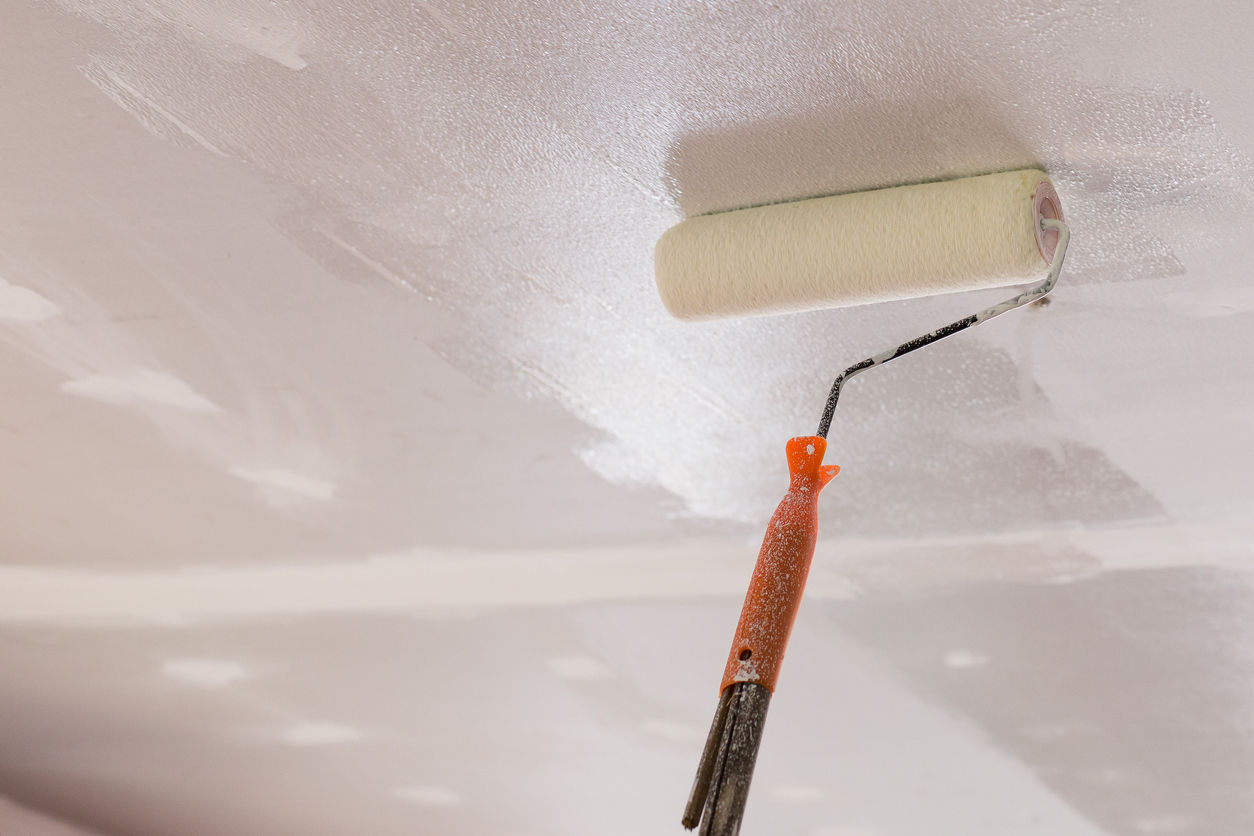How to paint a ceiling

In this guide I will explain how to paint a ceiling and the best paint to use. Since every room is different, this guide assumes that it an average sized room, that the ceiling has been previously painted, and that there is a minimal amount of preparation to do.
The guide will explain the following subjects:
-Health and Safety
-The tools and equipment that you will need
-The type paint that you will need
-How much Paint you will need
-How to prepare a Ceiling
-Tips for How to Paint a Ceiling
HEALTH AND SAFTEY
Before starting work, make sure you read the health and safety advice for painting and decorating from the Construction Industry Training Board here.
Important Points to consider in particular:
-Using a step ladder – make sure that someone supports the step ladder when you are using it. Always make sure you have three points of contact (both your feet and one of your hands). Never over-stretch.
-Beware of putting the feet of ladders on top of dust sheets that have been placed on top of hard floors. This use of dust sheets on hard floors can cause the feet of the ladder to slide.
-Always wear a dust mask (p3 grade) and protective eyewear when sanding any surfaces. Beware of lead paint. Lead is a hazardous substance and if dust that contains lead is breathed in or swallowed can have serious health implications. Although lead is no longer used in today’s paints, it can be present in properties built before the 1960s.
-If you encounter any asbestos then take care not to sand, cut it or disturb it in anyway as breathing in asbestos dust particles can be hazardous. If in doubt then ask an expert.
-It is recommended to use protective eyewear when rolling ceilings in order to prevent paint from getting in your eyes.
EQUIPMENT THAT YOU WILL NEED:

-Step Ladder (depending on how high your ceiling is)
-Dust Sheets (I usually use cotton dustsheets for the floor and new polythene sheeting for furniture and objects in the room)
-Dust mask (P3 standard)
-Dusting Brush
-Sandpaper – Grade 80 and 120 (you may also need grade 60 if there are some very rough areas that require sanding).
-Filler for the ceiling. You can buy either a powdered filler that you mix with water or a ready-mixed filler. I like to use a ready-mixed, lightweight filler made by Red Devil called ‘Onetime’ which is good for both fine filling and for large holes.
-Filling knife (if you only buy one, then I’d recommend a 2” wide filling knife)
-Scraper (it’s like a filling knife but stiffer)
-White Caulk and a caulk gun – caulk is used for filling cracks in internal corners, for example between the ceiling and walls or between the skirting board and the wall. The advantage of using caulk is that it is flexible, quick to apply and doesn’t require sanding. I like ‘No nonsense’ Caulk which can be bought from Screwfix and various other stores.
-Stanley Knife – for cutting the nozzle of the caulk tube
-Disposable gloves (optional)
-Stain block (depending on whether you have any water stains or felt pen stains that will bleed through the emulsion paint. If required then Zinsser Coverstain is a good oil-based stain block)
-White spirit for washing out the brush that you used for the stain block
-Painter’s hand wipes (available from most decorator’s merchants)
-Brush. Anywhere between 2-3” wide. The brush could be made of natural bristles, synthetic bristles or a mix of the two.
-Roller sleeve. You’ll need at least one roller sleeve. A 9”one is probably best, and while there are some good, cheap synthetic ones on the market, I prefer to spend slightly more and use Sheepskin rollers as they provide a good finish and are easier to clean afterwards.
-Roller Frame.
-Roller pole. Make sure that it fits the roller frame that you buy. If the pole has a screw fitting at the end then you’ll either need a roller frame that accepts this or you will need to buy an adapter. If you are planning to do a lot of decorating then it’s worth spending a bit more and buying a decent pole as the cheaper ones tend to break quickly.
CHOOSING THE TYPE OF PAINT:

Kitchens/Bathrooms:
If you are painting a ceiling in a kitchen or bathroom then you might want to consider a wipeable finish . As well as having the benefit that dirt and stains can be easily removed, I tend to recommend this in small bathrooms that do not have windows, because the steam from the shower can cause standard matt paint to become temporarily transparent and to show up areas that have been filled. In terms of wipeable finishes, there are three options:
-Silk emulsion – this is a very shiny finish and a bit unfashionable these days
-Mid-sheen emulsion (self-explanatory)
-Wipeable matt emulsion such as Crown ‘Clean Extreme’ or Dulux ‘Diamond Matt’
(I tend to recommend the last option as it looks much more attractive.)
Normal Rooms (such as Living Rooms, Bedrooms etc:
for all other rooms, you’ll probably want to use a matt emulsion. Daylight usually hits ceilings from a sideways angle and this can sometimes mean that it shows up roller marks if the paint has even a slight sheen. For this reason, in living rooms, bedrooms and hallways, I tend to either use Dulux ‘Flat Matt’ emulsion or Johnstone’s Perfect Matt emulsion, as they tend to solve this problem.
HOW MUCH PAINT WILL I NEED ?
This will depend on the size of the room. Assuming that you will be applying 2 coats of paint, you’ll probably need 2.5 Litres for small rooms or 5 litres for larger rooms.
PREPARING THE CEILING :
1. Begin by removing as many possessions as possible from the room. Cover up anything that you can’t remove with sheeting and protect the floor with cotton dust sheets.
2. Bring all of the equipment/materials that you will need for the preparation into the room but leave things like paint and rollers out of the room as you don’t want to cover these items with dust.
3. Begin by sanding any rough areas on the ceiling, making sure that you use a dust mask and eye protection and it may be necessary to open windows to allow suitable ventilation. The grade of sandpaper that you use will depend on how rough the areas are. If you see any hairline cracks, then using the corner of the scraper to open them up a little bit in order to make them easier to fill. Remove dust with a dusting brush.
4. Take your filing knife and filler and fill any crack and holes. Don’t worry too much about making it look perfect as you will sand these areas once dry. If you are using a lightweight filler like Red Devil ‘One Time’ Filler then you can fill holes ‘flush’ with the ceiling. If using other types of filler then it is a good idea to fill any holes slightly ‘proud’ (so that the surface of the filler is slightly raised). This is because most filler dries by evaporation and it will therefore shrink slightly when it dries, meaning that you will have to fill it a second time.
5. While the filer is drying, you can fill any cracks between the ceiling and walls with the decorator’s caulk. Squeeze the trigger of the caulk gun and apply little bit of caulk at a time (perhaps a metre in length). Smooth the caulk with your finger straight away. It helps to have a pot of water and a cloth handy so that you can wash your finger in between applications. Using a damp finger also helps to smooth out the caulk. The advantage of using caulk is that it doesn’t need to be sanded afterwards. This does mean that you need to make sure that it looks good before it dries.
6. Once the filler has dried, sand it down and dust these areas off with a brush.
7. If you have had any leaks in the past and have water stains on the ceiling, then these will need to be sealed with stain-block before painting with emulsion, otherwise the stains will bleed through. Oil-based stain blocks work the best, and I tend to use Zinsser Coverstain for two reasons. Firstly, it dries quickly (it can be painted over after only an hour or two), and secondly because although it is oil-based it dries to a matt finish and therefore the emulsion adheres to it well.
TIPS – HOW TO PAINT A CEILING:
-Once you have finished all of the preparation and removed all dust from the room, you are ready to start painting. Before you roll the ceiling, paint the edges of the ceiling with a brush – a 4 inch wide band of paint should be enough.
-When rolling the ceiling, the best place to start is near the windows. This is because as you work backwards from that point, the daylight will reflect in the wet paint and it will make it easier to see whether or not you have missed any areas.
-Make sure that you roll in the same direction, overlapping each area that you apply slightly.
-Try to keep a ‘wet edge’ at all times. While this is difficult, what this means is you should try not to let an area of paint dry before you roll an adjacent area otherwise your roller marks may become visible.
-If you have a window/windows at one side of the room only, then roll the whole width of the room at that point before rolling areas that are further away from the window. See diagram below.

-When you apply the second coat with the roller, start near the windows as before, but this time change the rolling direction by 90 degrees (see diagram below).
-If you don’t have time to apply the second coat before the end of the day , then you can wrap your brushes and rollers tightly in a plastic bag to prevent the paint drying out. This will save time as you will only have to wash your brushes and rollers at the end of the job.
If you want to continue and paint the walls and woodwork, then you can read my guide on How to Paint a Room.
BACK TO BLOG
Follow US
